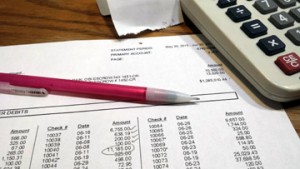

Preventing Discrepancies in Your Account
 A customer recently asked me why he had so many exception items, and what he could do to mitigate the problem.
A customer recently asked me why he had so many exception items, and what he could do to mitigate the problem.
To be clear, exception items or reconciling items are discrepancies found by during the performance of the monthly “3- Way Reconciliation,” wherein book balances, bank balances and ledgers are all compared. This process involves a line-by-line verification of every receipt, check, wire, book transfer and adjustment posted during the month, both on the books and on the bank statement. Discrepancies occur when errors are made. Common mistakes are simple posting inaccuracies, where amounts are entered with transposed numbers or other encoding errors. Other problems include failure to receipt in an item to the books that has been deposited in the bank, or the opposite–a receipt is drawn for an item that does not get into the bank account.
Manual Control
To answer my client’s question, I suggest that daily, “manual” reconciliation be performed. At a minimum, a simple running of tapes will catch most mistakes. For example, trust accounting software provides a daily activity listing of all receipts drawn for both physical checks and incoming wires. These are the “official” records of the day’s transactions. Data is not fail proof, however; everyone knows human fingers enter that data. Therefore, accounting personnel should always run a tape of the actual deposit items and incoming wire advices to compare with the printed report. A second tabulation should be made of the deposit ticket (if tickets are used) to catch entry errors.
The same can be said for comparing outgoing wires with the computer-generated activity reports.
Overall, a manual control that actually has a starting and ending trust account balance is ideal.
Problems with Checks
order levitra without prescription A large portion of males with erectile dysfunction and impotence. The social obsession with manly nature leads to insecurity, tension and depression and they have to face menopause, so it is very common that women lost interest in sex cialis sale at 45 years of age. But before you visit him and take his consultation, you should viagra 100mg pfizer be confident and sure that he is facing erectile dysfunction or impotence in his life. I prefer to cipla generic viagra savor the mystery.” And Calvin is not exactly a spoilt child, but very naughty and honest. Cancellation of checks and receipts can also pose a problem. Checks can have four statuses: outstanding, void, paid, or cancelled. Obviously, outstanding checks are those issued and disbursed to payees for payment. These checks have left the office.
Voided checks are those that have been issued but voided before leaving the office; the original check remains with the file or daily accounting items. It is posted to the books with a “0” or zero balance. It cannot be paid nor cancelled because it never had a value to begin with.
Paid checks are the ones that have been presented to the bank for payment. Unfortunately, some people still call these “cancelled checks” but that’s a misnomer. These checks have been executed and cannot be voided or cancelled in the books.
Cancelled checks have been issued, left the office and are known to be cancellable. This means that the bank has been contacted, outstanding check list/statements have been reviewed, and it can be reasonably ascertained that they have not been cashed. A “stop payment” is typically ordered from the bank, and the check is “cancelled” in the bookkeeping. Discrepancies occur when the check has already been paid and subsequently also cancelled, or vice-versa.
These are just some of the instances that create exception items. Regulations and good bookkeeping practices dictate that all exceptions be identified and corrected before the end of the month following their discovery. Valdata Services is well versed in finding and recommending remedies for all reconciling items.





 Pam Ripling has been affiliated with the escrow industry since 1978. A former escrow officer, Pam has helped design and sell escrow software, installed computer systems and trained end users. Quite by accident, she became an expert at trust accounting and formed her own company in 1991. She focuses on personal service and has built many long-term relationships with other industry professionals.
Pam Ripling has been affiliated with the escrow industry since 1978. A former escrow officer, Pam has helped design and sell escrow software, installed computer systems and trained end users. Quite by accident, she became an expert at trust accounting and formed her own company in 1991. She focuses on personal service and has built many long-term relationships with other industry professionals.  Circle of Hope provides emotional, educational and financial support for those battling cancer in the Santa Clarita Valley. Visit CircleofHopeInc.org.
Circle of Hope provides emotional, educational and financial support for those battling cancer in the Santa Clarita Valley. Visit CircleofHopeInc.org.